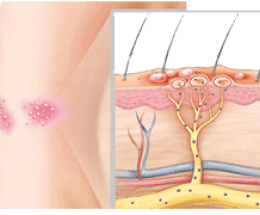Postherpetic neuralgia is a painful condition that affects the nerves of the skin. It is a complication of herpes zoster virus, commonly known as shingles. Shingles is a painful, blistering rash caused by reactivation of the virus called varicella-zoster, which people usually get during childhood (chickenpox). Once someone has had chickenpox, the virus that caused it can remain dormant in some of the body’s nerve cells. As people age, the virus can reactivate. The result is a shingles rash. Since there is some immunity against the virus, rather than a full body rash, the rash occurs in areas of skin supplied by the nerve where the virus is reactivated. Pain that persists long after the shingles rash and blisters have disappeared is called postherpetic neuralgia. It occurs when a person’s nerves are damaged during the shingles outbreak. The damaged nerves cannot send messages from the skin to the brain correctly, and they become confused. This results in chronic severe pain that can last for months, or even years.
The risk of getting shingles as well as postherpetic neuralgia increases with age, and is more likely to occur in people over the age of 60.


The signs and symptoms of postherpetic neuralgia are generally limited to the area if skin where the shingles outbreak first occurred. Signs and symptoms include pain commonly described as burning, sharp and stabbing, or deep and aching. Symptoms also include sensitivity to light touch or temperature changes
Upon examination of the patient, there may be evidence of scar formation on the skin at the site that had been recently affected by herpes zoster.
The best way to diagnose postherpetic neuralgia is through clinical history and examination. Rarely are additional investigations such as a viral culture or antibody measurements towards herpes zoster virus required.

Tricyclic Antidepressants (TCA) are normally prescribed to treat depression, however theyappear to have a powerful analgesic effect and can reduce pain associated with postherpetic neuralgia. They often have side effects, like dry mouth and blurred vision. Commonly used TCA’s include:
A herpes zoster vaccine called Zostavax can reduce the risk of shingles by 50%. It can also protect against postherpetic neuralgia. The vaccine is given to all adults over the age of 60.
This information is for educational purposes only and is NOT intended to replace the care or advice given by your physician. Always seek the advice of your physician or other qualified health provider before starting any new treatment or with any questions you may have regarding a medical condition. For more information see our Medical Disclaimer.